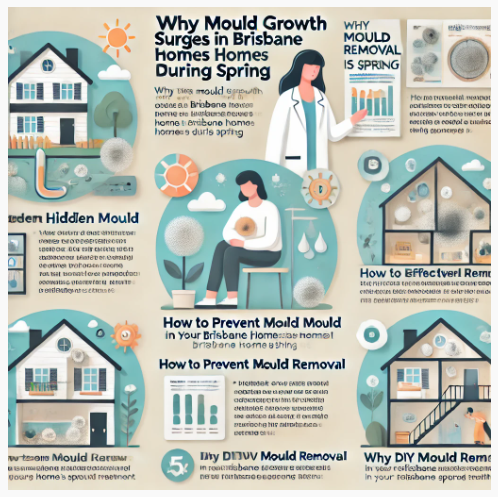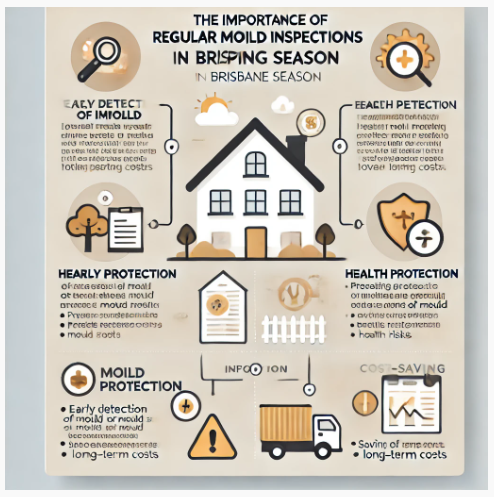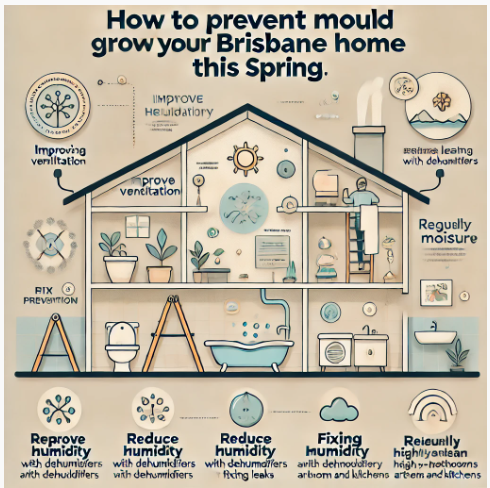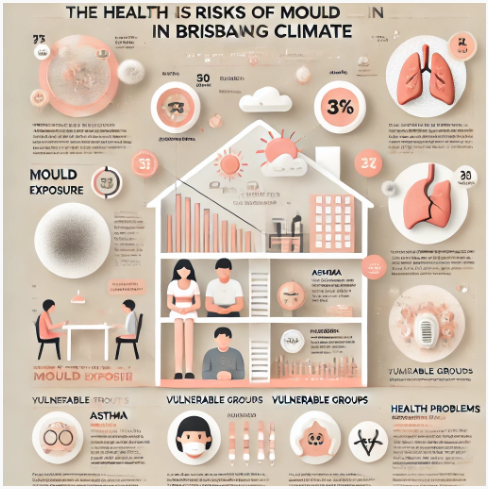Why Mould Growth Surges in Brisbane Homes During Spring
Spring in Brisbane is a time of renewal and growth. Unfortunately, it’s also a time when mould growth becomes a significant issue in homes across the city. The combination of warmer temperatures and high humidity creates the perfect environment for mould to thrive. While many people focus on outdoor spring cleaning, the risks associated with indoor mould growth can be overlooked.
This article explores the reasons behind the surge in mould growth during Brisbane’s spring, the dangers it poses, and why it’s crucial to address mould issues early in the season.
Brisbane’s Spring Climate: A Breeding Ground for Mould
Brisbane’s spring climate is characterised by warm temperatures and increased rainfall. According to the Australian Bureau of Meteorology, Brisbane experiences average spring temperatures between 20°C and 30°C, with humidity levels often exceeding 70%. These conditions are ideal for mould growth, as mould spores thrive in moist, warm environments.
Mould reproduces by releasing microscopic spores into the air. These spores can settle on any damp surface and begin to grow within 24 to 48 hours. Spring rains and high humidity increase moisture levels in homes, making it easier for mould to spread, especially in areas with poor ventilation.
Statistics from the Queensland Department of Health show that Brisbane homes are at higher risk of mould infestations during the spring months due to the city’s tropical and subtropical climate. The increased moisture inside homes—combined with higher temperatures—creates the perfect environment for mould to develop quickly.
Common Areas for Mould Growth in Spring
Mould can grow in various areas of the home, but it tends to thrive in damp, poorly ventilated spaces. During spring, the following areas are most vulnerable to mould infestations:
- Bathrooms: Bathrooms are highly prone to mould growth due to frequent use of water and the resulting condensation. Steam from showers and baths raises the moisture level, particularly on walls, ceilings, and grout.
- Kitchens: Kitchens, like bathrooms, generate a lot of moisture. Steam from cooking, dishwashing, and poor ventilation can create damp conditions that encourage mould growth on walls, windows, and cabinets.
- Bedrooms: Condensation from windows and poor airflow make bedrooms, particularly those without adequate ventilation, a target for mould growth. Mould can also develop on carpets, curtains, and mattresses.
- Roofs and Gutters: Spring rains can cause roof leaks, leading to damp ceilings and walls. Clogged gutters can also trap water, allowing it to seep into the home and create the perfect environment for mould.
- Basements and Crawl Spaces: These areas often remain damp due to lack of airflow and can become breeding grounds for mould, especially during Brisbane’s humid spring.
The Health Risks of Mould Exposure
Mould is not just an aesthetic issue—it poses significant health risks, particularly during spring when Brisbane’s weather increases mould growth. Mould releases allergens and irritants that can negatively affect indoor air quality, leading to respiratory problems.
According to Queensland Health, prolonged exposure to mould can trigger various health problems, including:
- Allergies: Mould spores can cause allergic reactions such as sneezing, runny nose, red eyes, and skin rashes. These symptoms can worsen in spring due to higher mould spore counts in the air.
- Asthma Attacks: Mould is a known trigger for asthma attacks. Asthma Australia reports that up to 80% of people with asthma in Brisbane are allergic to mould. During spring, asthma symptoms can worsen as mould spores proliferate in warm, humid conditions.
- Respiratory Infections: For people with weakened immune systems, prolonged exposure to mould can lead to respiratory infections. Infants, the elderly, and those with pre-existing respiratory conditions are particularly vulnerable.
A study conducted by CSIRO found that indoor air quality is often worse than outdoor air quality, especially in homes with mould problems. This is especially concerning during spring, when windows are often closed to prevent rain from entering, trapping mould spores indoors.
The Financial Impact of Mould Infestations
Mould not only poses health risks but can also cause significant damage to your home. If left untreated, mould can spread to walls, ceilings, and floors, causing structural damage. Mould can weaken wooden beams, drywall, and insulation, leading to expensive repairs.
According to the Insurance Council of Australia, mould-related claims have risen in recent years, with many homeowners facing repair bills ranging from $5,000 to $15,000 to fix damage caused by long-term mould infestations. These costs can be even higher if mould is found in hard-to-reach areas such as wall cavities or roofing.
The financial burden of repairing mould damage underscores the importance of addressing mould issues early. Regular inspections and professional mould removal services can prevent minor infestations from turning into costly problems.
The Role of Spring in Mould Proliferation
Spring is the season when mould growth accelerates the fastest. There are several reasons for this increase:
- Warmer Temperatures: Spring brings warmer temperatures, which accelerate the growth rate of mould. As temperatures rise, mould spores reproduce more quickly, leading to visible growth in as little as 24 hours.
- Increased Rainfall: Brisbane typically experiences spring showers, which raise humidity levels both inside and outside the home. This increased moisture creates the perfect environment for mould to settle and grow, especially in areas prone to leaks or condensation.
- Longer Days: Longer daylight hours can result in higher indoor temperatures, especially in poorly ventilated spaces. Warm air traps moisture in the home, making it easier for mould to thrive.
- Spring Cleaning: Ironically, spring cleaning efforts can sometimes contribute to mould growth. Cleaning with water and leaving surfaces damp can provide mould spores with the moisture they need to spread. Additionally, moving furniture or items stored over winter can uncover hidden mould, releasing spores into the air.
Why Professional Mould Inspections Are Essential in Spring
Given the surge in mould growth during spring, professional inspections are essential to ensure that mould doesn’t become a larger issue. While many homeowners attempt to remove mould with DIY cleaning solutions, these methods often only treat surface mould and fail to address hidden infestations.
At Reliance Mould Solutions, our mould inspection process includes:
- Thorough visual inspections: We inspect high-risk areas of your home for visible signs of mould growth.
- Moisture detection: Using specialised equipment, we measure moisture levels in walls, ceilings, and floors to identify areas where mould is likely to grow.
- Air and surface sampling: We take samples from the air and surfaces to detect mould spores that may not be visible to the naked eye. These samples are analysed in a laboratory to determine the type and extent of mould present.
By detecting mould early, homeowners can prevent larger infestations from developing and avoid the health risks associated with long-term exposure.
Take Action Against Mould This Spring
Spring in Brisbane creates the perfect conditions for mould growth, but with regular inspections and early intervention, you can protect your home and health from the dangers of mould. The combination of warm temperatures, high humidity, and increased rainfall makes spring the most critical time to address mould issues before they escalate.
At Reliance Mould Solutions, we offer comprehensive mould inspection and removal services to help Brisbane homeowners tackle mould growth before it becomes a major problem. Contact us today to schedule an inspection and ensure your home remains mould-free this spring.
Read our article on The Health Risks of Mould Exposure in Brisbane




